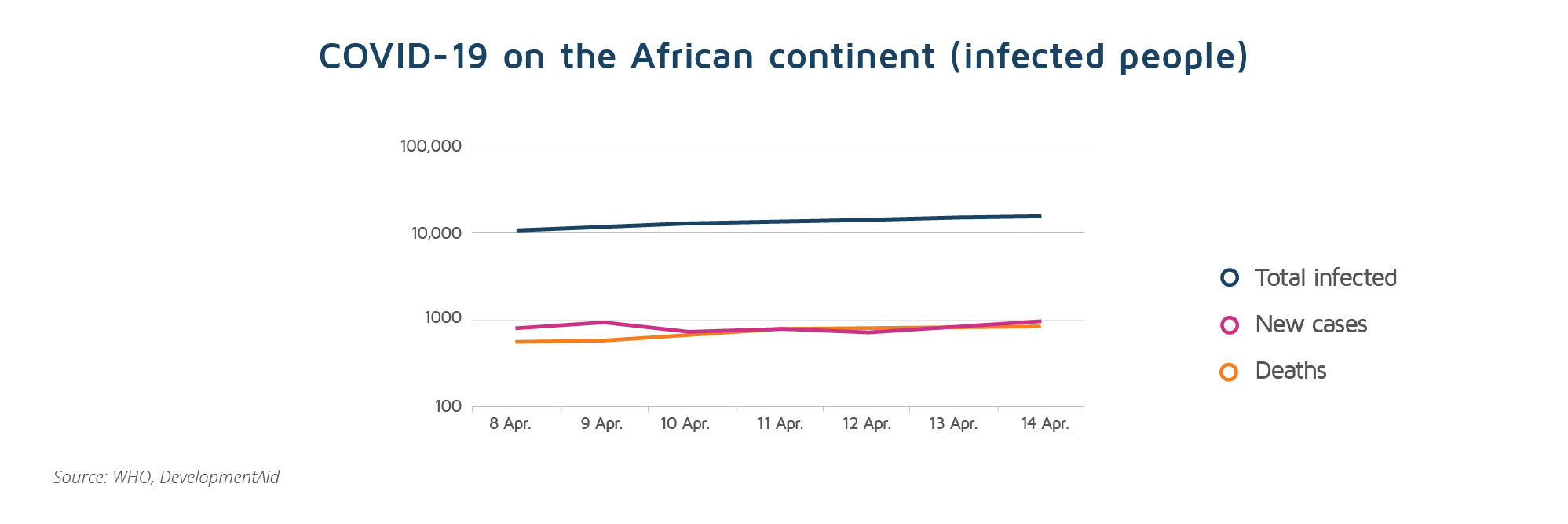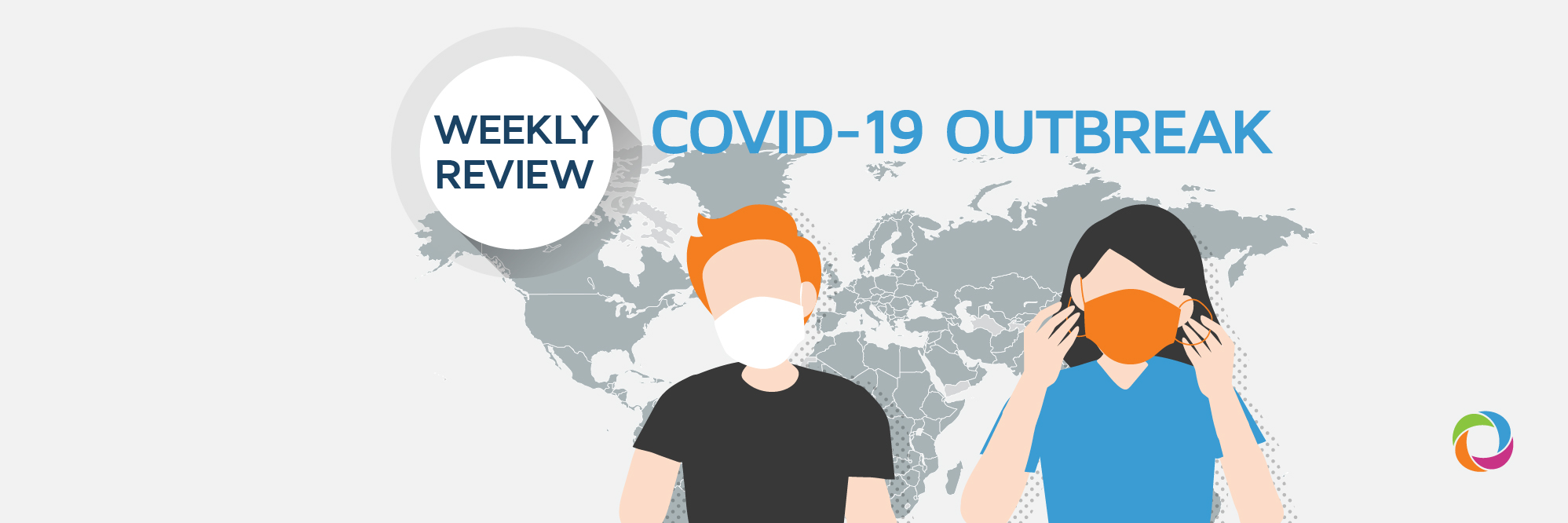(April 8 – 14, 2020)
Despite slowly reaching the 2 million mark of COVID-19 infected people around the globe, last week’s trends offer a glimmer of hope. Eight out of the ten most affected countries have registered downward trends in the number of new daily cases during the last five days with USA, Italy, Spain, Iran, Belgium, France, Germany and the Netherlands reporting fewer new COVID-19. At the same time, among those nations encountering upward trends are the United Kingdom and China where 93 new patients were diagnosed on April 14th.
The encouraging trends could be the fragile result of each country’s efforts to flatten the curve of new COVID-19 patients. Reducing this number is of utmost importance to national health systems which otherwise may become overwhelmed.
As of today, around 500,000 people have recovered from the disease. Unfortunately, the number of deaths has now reached 127,000 thousand according to the COVID-19 dashboard created by the Center for Systems Science and Engineering at Johns Hopkins University.
While in developed countries health systems are more or less prepared to respond to the pandemic, in other regions the COVID-19 virus could be more devastating. According to the World Health Organization (WHO), the African region has the lowest proportion of countries with a national pandemic influenza preparedness plan. However, only one fifth of those countries have held simulation exercises to test those plans during the last five years.
On April 7th, the WHO reported that there are 10,000 cases of COVID-19 in Africa. Since February 14th when the first patient was recorded in Cairo, Egypt, all 52 countries of that continent have now reported cases. Today, there are 15,879 COVID-19 cases, of which 834 deaths.
 “COVID-19 has the potential not only to cause thousands of deaths, but to also unleash economic and social devastation. Its spread beyond major cities means the opening of a new front in our fight against this virus”
“COVID-19 has the potential not only to cause thousands of deaths, but to also unleash economic and social devastation. Its spread beyond major cities means the opening of a new front in our fight against this virus”
Dr Matshidiso Moeti, World Health Organization (WHO) Regional Director for Africa.
Africa also hosts almost 26% of the world refugee population and, out of the total of 6.3 million African refugees in 2018, almost 5 million of these found shelter in refugee camps, according to UNHCR. There are countless refugee camps with limited access to basic needs such as water and soap, for example.
Ali Al Mokdad has spent the last 16 months in South Sudan where he cooperated with the International Medical Corps and the Norwegian Refugee Council. When contacted by DevelopmentAid, he suggested that the situation is ominous. “Refugee camps and the coronavirus is a catastrophe waiting to happen – there have been stark warnings from doctors, aid workers, INGOs and the United Nations about that. Sanitation and hygiene levels are not ideal. We teach people that they should wash their hands a lot and do certain things to aid prevention but most of the time they don’t have water or soap.”
Mr. Al Mokdad expressed concern over the ability to contain the outbreak if it does happen in one of the camps. “During the past years, NGOs were facing challenges in camps, POCs and refugees’ statements in terms of health and hygiene promotion but funding was always a key factor in not implementing a multi-sectoral intervention or establishing good water and sanitation system. A large proportion of the population is made up of children, and it’s hard to make them understand the need for isolation and extra handwashing. My real concern is that this is a very crowded environment so, if we do have cases, it will be very hard to contain.”
At the same time, some NGOs from the region have been giving out Personal Protective Equipment (PPE) to the aid workers operating in the camps. So far there have been no reports of COVID-19 cases in refugee camps.
Meanwhile, the United Nations has announced details of the first “Solidarity Flight” – an aircraft carrying vital medical cargo to every country in Africa. The cargo includes face shields, gloves, gowns, masks, medical aprons and thermometers, as well as ventilators.
The Lockdown-effect
The April World Economic Outlook predicts that global growth will fall to -3% in 2020. This IMF publication concludes that, because of COVID-19, the world economy will experience the worst recession since the Great Depression and its effects will be far worse than the 2009 global financial crisis. However, the organization is optimistic about 2021. Assuming the pandemic wanes in the second half of 2020 and that the policies adopted by governments are effective, it projects a 5.8% growth the following year.
Until then, the IMF has announced immediate debt relief for its 25 poorest member-countries. The intention is to help these countries to channel more financial resources towards vital emergency medical and other relief efforts.
This announcement came after 60 international agencies pressed for a rapid and coordinated response from governments and the donor community to prevent the potentially devastating debt crisis. Among other actions requested was the immediate suspension of debt payments from Least Developed Countries and other low-income states.
In Asia, the Asian Development Bank has tripled the size of its response to the novel coronavirus disease to US$20 billion by adding an additional $13.5 billion to its initial US$6.5 billion response announced on March 18th. The resources will help ADB developing member countries to counter the macro-economic impacts triggered by COVID-19. Among other beneficiaries, US$2 billion will be available for private sector support with loans and guarantees being provided to financial institutions to rejuvenate trade and supply chains.
During the past seven days, Japan has contributed US$6 million to support the International Organization for Migration COVID-19 response across Asia. This donation will be used to help Iran and surrounding developing countries to prevent the spread of the COVID-19.
[Read: Financing of pandemic response: where does the money come from?]
DevelopmentAid provides weekly reviews of the coronavirus situation across the world. You can read the previous editions by accessing this link. Stay tuned for our next weekly journal to be published on April 22nd
About COVID-2019 Coronaviruses are a large family of viruses that are common in many different species of animals including camels, cattle, cats and bats. Rarely, animal coronaviruses can infect people and then spread between them such as was the case with MERS (2012) and SARS (2003).The symptoms of the virus are very similar to those of a common cold – runny nose, headache, cough, sore throat, fever, a general feeling of being unwell. Blood tests are necessary in order to prove the presence of the virus in the organism. Named by scientists as the “Wuhan seafood market pneumonia virus”, COVID-19 is a coronavirus, like MERS and SARs, all of which have their origins in bats. Initial reports show that, in the early stages of the outbreak (early January 2020), many of those infected in Wuhan had some link to a large seafood and live animal market – the Huanan Seafood Wholesale Market, mainly its western wing where wildlife animals are traded. This suggests that the virus initially affected an animal and subsequently spread to a person in a what a CDC has called “the species barrier jump”.


